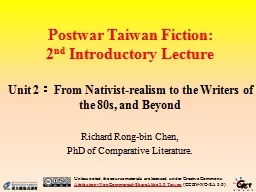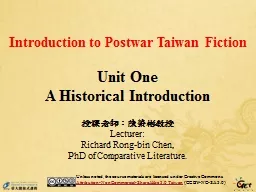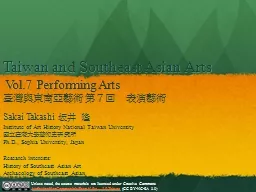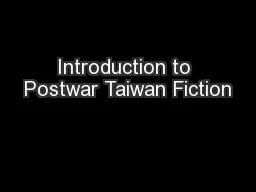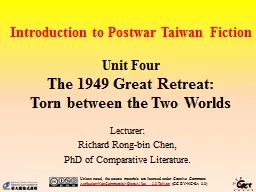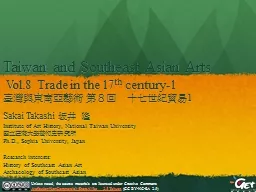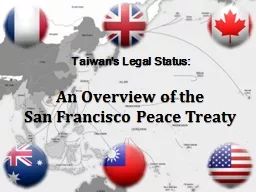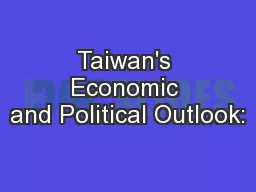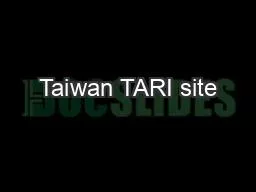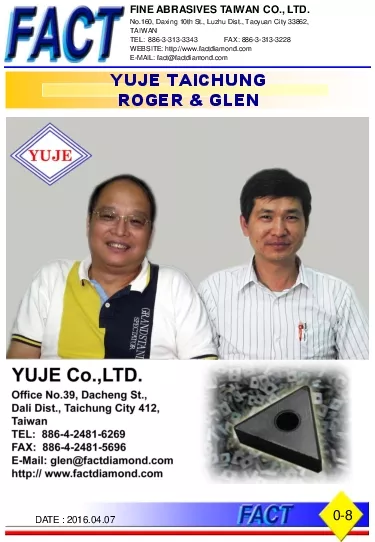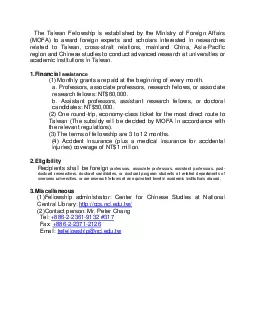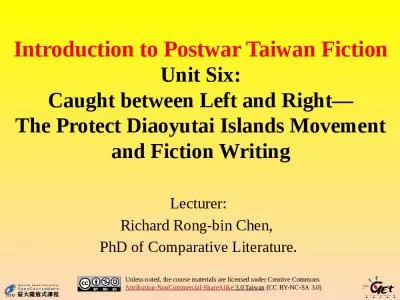PPT-Postwar Taiwan Fiction:
Author : tawny-fly | Published Date : 2016-04-18
2 nd Introductory Lecture Unit 2 From Nativist realism to the Writers of the 80s and Beyond Richard Rong bin Chen PhD of Comparative Literature Unless noted
Presentation Embed Code
Download Presentation
Download Presentation The PPT/PDF document "Postwar Taiwan Fiction:" is the property of its rightful owner. Permission is granted to download and print the materials on this website for personal, non-commercial use only, and to display it on your personal computer provided you do not modify the materials and that you retain all copyright notices contained in the materials. By downloading content from our website, you accept the terms of this agreement.
Postwar Taiwan Fiction:: Transcript
2 nd Introductory Lecture Unit 2 From Nativist realism to the Writers of the 80s and Beyond Richard Rong bin Chen PhD of Comparative Literature Unless noted the course materials are licensed under Creative Commons . in. Southeast . Asian Regional . Contexts. Bien Chiang. Institute of Anthropology, National Tsinghua University. Institute . of Ethnology, Academia Sinica. 2012/3/20. National Kaohsiung University . Vol.. 5. Overseas Chinese Culture 2 . 臺灣與東南亞藝術 第. 5. 回 華人文化. 2. Unless noted, the course materials are licensed under Creative Commons . Attribution-. NonCommercial. -. Taiwan Fiction. 授課老師:陳榮彬教授. Lecturer:. Richard . Rong. -bin Chen, . PhD of Comparative Literature.. Unit One. A . Historical Introduction. 1. Unless noted, the course materials are licensed under Creative Commons . Vol.7 Performing Arts . 臺灣與東南亞藝術. 第7回 表演藝術. Unless noted, the course materials are licensed under Creative Commons . Attribution-. NonCommercial. -. ShareAlike. 3.0 Taiwan. Unit Five. Wars against the Communists:. Taiwan behind the Scenes of the Korean and Vietnamese Wars. Lecturer:. Richard . Rong. -bin Chen, . PhD of Comparative Literature.. Unless noted, the course materials are licensed under Creative Commons . Unit Four. The 1949 Great Retreat:. Torn between the Two Worlds. Lecturer:. Richard . Rong. -bin Chen, . PhD of Comparative Literature.. Unless noted, the course materials are licensed under Creative Commons . Vol.8 Trade in the 17. th. century-1 . 臺灣與東南亞藝術 第. 8. 回 十七世紀貿易. 1 . Sakai Takashi. . 坂井 隆. Institute of Art History, . National Taiwan University. . 國立臺灣大學. An . Overview of . the . San . Francisco Peace Treaty. Preliminary Issues for a Discussion of the . San Francisco Peace Treaty (SFPT). under US law. What is the legal status of the SFPT under U.S. law?. Summer Challenges. Presented by Ross Darrell Feingold to the. Taiwan Business Leaders Forum. 29 June 2017. Personnel & Policy Developments. Taiex. is up:. 2. Apple store opening.. Global sympathy over WHA, Panama.. JECAM JECAM/GEOGLAM Science Meeting Brussels, Belgium 16 - 17 November, 2015 Investigators: Dr. Chi - Farn Chen, CSRSR, NCU, Taiwan Mr. Horng - Yuh Gua, TARI, Taiwan Dr. Nguyen Thanh Son, CSRSR, NCU, DATE No160 Daxing10th St LuzhuDist Taoyuan City 33862 TAIWANTEL 886-3-313-3343 FAX 886-3-313-3228WEBSITE http//wwwfactdiamondcom E-MAIL factfactdiamondcomYUJE TAICHUNGROGER GLEN 886-2-2361-9132 317 Fax 886-2-2371-2126twfellowshipncledutw Dr. . Bor-Fuei. “Apo” Huang. Secretary General . Taiwan Bio Industry . Organization. www.taiwanbio.org.tw. apohuang2@gmail.com. Taiwan Bio Industry Organization . Taiwan ─ “ . Ilha. Formosa”. Unit Six:. Caught between Left and Right—. The Protect . Diaoyutai. Islands Movement and Fiction Writing. Lecturer:. Richard . Rong. -bin Chen, . PhD of Comparative Literature.. Unless noted, the course materials are licensed under Creative...
Download Document
Here is the link to download the presentation.
"Postwar Taiwan Fiction:"The content belongs to its owner. You may download and print it for personal use, without modification, and keep all copyright notices. By downloading, you agree to these terms.
Related Documents

